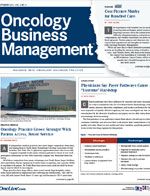Publication
Article
Oncology Business News®
Seeing ICD-10 Through the Lens of Constructive Change
Author(s):
A huge amount of training and preparation has preceded the October 1 implementation of International Classification of Diseases, Tenth Revision (ICD-10).
OncLive Chairman,
Mike Hennessy
A huge amount of training and preparation has preceded the October 1 implementation of International Classification of Diseases, Tenth Revision (ICD-10). However, when the system goes live, it will not be an opportunity for oncology practices to kick back and watch it all happen on the monitors. This will be the real test of whether multiple players in the oncology field and elsewhere can truly integrate with this new set of tens of thousands of new codes—171,000 versus 17,849 under ICD-9.
Many physicians and administrators, with their minds focused on multiple activities, may view ICD-10 as a somewhat eccentric assortment of codes that have introduced enormous complexity into their working lives while almost promising to slow down the revenue cycle, push billing staff into prolonged negotiations with payers over coding disputes, and send blood pressure readings through the roof. ICD-10 codes like W56.22xA, “Struck by orca,” do not make it any easier to appreciate the value of this ordeal.
Experts say that underlying this transition are some very positive changes that, in the end, will make life significantly better for physicians and other practice members. The more specific reporting required under ICD-10 will create a detailed portrait of a physician’s care of a patient, thus helping to validate the treatment decisions that are made and providing a clear record of the actions taken. The result will be better understanding of a patient’s condition and a record that, in part, legitimizes the treatment path that is followed. Physicians will not only be able to justify the compensation they are entitled to but also demonstrate that they followed proper procedure, should they happen to be subject to an audit or legal investigation. Last but not least, the added healthcare data will contribute to better communication among health authorities and potentially to the development of better clinical pathways and disease protocols.
For now, however, these anticipated fruits of ICD-10 have yet to grow on the vine. Physicians and practice administrators can see only the stress involved in bringing staff up to speed on these changes, while staving off the potential problems of implementation: payer denials, overlooked coding requirements, and revenue interruption, all of which is covered in the September issue of Oncology Business Management.
In this issue, we also examine 2 kinds of value-driven payment tools making their way to the fore: pathways and single-payment bundled care. For many physicians used to the fee-for-service way of doing things, these new paradigms require a very different emphasis on costs and the approach to treatment. Some chafe under this new orthodoxy, which statistics show is becoming more entrenched with each year that goes by. Pathways were in use by 39% of payers, according to a 2012 study that also noted that 59% of those surveyed intended to adopt them within 2 years. Physicians contend that the diversity of pathways among competing payers is overwhelming and that payers are using this value and care-improvement tool to micromanage decision making.
Payers are merely trying to “encourage physicians to consider the relative value of various treatment options,” Michael Kolodziej, MD, national medical director of oncology solutions at Aetna and a former medical director at US Oncology, told Oncology Business Management.
Our September feature on single-payment systems indicates that payers are increasingly confident about applying bundled care to oncology, especially when fortified by large patient cohorts that provide the statistical foundation needed for reliable predictions about cost versus outcome. Blue Cross Blue Shield of New Jersey recently began a breast cancer bundled program, and UnitedHealthcare’s Lee Newcomer, MD, senior vice president for oncology, says lung cancer treatment is so erratic in this country that he’d like to make that the next focus for a single-payment system.
“We think that putting centers in big metropolitan areas who are focused on lung cancer and lung cancer only would improve the results,” Newcomer says.
Any way you look at it, changes are settling in on a broad scale. Read all about it in September’s Oncology Business Management.










